Restoring Rice Paddies and Rice Agro-Ecosystem Services Through a Participatory Seed Conservation and Exchange Programme (SITR8-7)
20.03.2024
SUBMITTING ORGANIZATION
M. S. Swaminathan Research Foundation (MSSRF), Community Agrobiodiversity Centre
DATE OF SUBMISSION
19/09/2023
REGION
Asia
COUNTRY
India
AUTHOR(S)
Archana Bhatt
N. Anil Kumar
C. S. Dhanya
P. Vipindas
LINK
1 Introduction
Rice has been a staple crop in the majority of Asian nations since time immemorial and has evolved itself within various landscapes and food patterns that span borders. Rice agro-ecosystems across Asia are highly diverse in terms of varieties, cultivation practices, and food patterns, depending on the regions and community spread throughout the entire continent. This diversity also allows high nutritional benefits and helps ensure the food and nutritional security of communities (Zeng et al. 2010; Umadevi et al. 2012).
In the era of the Green Revolution of the 1960s, revolutionary steps were made towards combating hunger through the introduction of High Yielding Varieties (HYVs) of rice and wheat, coupled with the use of fertilisers and machinery. But along with the benefits came the decline in traditional paddy varieties (Parayil 1992; Eliazer Nelson et al. 2019; Roy et al. 2018). India alone was once home to around 200,000 landraces of rice (Richharia and Govindasamy 1990), many of which formed part of the cuisine and various religious rituals as reported in the ancient texts of Ayurveda (Jose et al. 2018; Sathya 2013). The HYVs, combined with increased and uneven use of fertilisers and pesticides, added up to the loss of many other organisms in the food web of the rice agro-ecosystem (Kumar 2017). Moreover, extreme weather events, especially delayed monsoons, droughts, and floods due to untimely heavy rains have become a major factor contributing to the decline in rice cultivation over the past decade. Various studies reflect that the productivity of many crops, including rice, is expected to be significantly reduced in the coming decades due to increased climate variability and climate change (Salinger et al. 2005; Godfray et al. 2010; van Noordwijk et al. 2018).
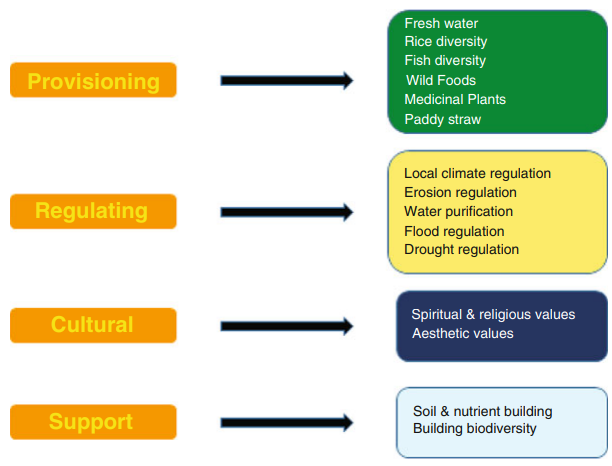
Paddy agro-ecosystems generate a number of services (Chivenge et al. 2020) and support diverse species that use the paddy fields as their habitat or food source. In terms of biodiversity and ecosystem services, a wetland paddy field provides various aspects of provisioning, regulating, supporting, and cultural services for communities (Fig. 8.1). A typical rice agro-ecosystem is home to many other species apart from the rice that is cultivated in the field. A study conducted by Parameswaran and Kumar (2017) reported 95 plant species in a paddy agro-ecosystem (dominated by the members of Cyperaceae, Asteraceae, Poaceae, Amaranthaceae families) that were of direct use value to communities as wild edible greens or medicinal herbs. Rice paddies also provide habitats for birds, insects, fish, and other forms of diversity, which in turn helps to reduce incidences of pest damage (Kumar et al. 2022). A small field of paddy rice is actually a complex web of diversity woven into an agro-ecosystem that supports various life forms. Therefore, a decline in rice cultivation and the diversity of varieties cultivated eventually results in a threat to ecosystem services in their entirety.
Furthermore, traditional crop production practices help in maintaining agrobiodiversity, which in turn also helps in conserving the associated cultural wisdom important for crop productivity (Cox 2000; Maffi 2002). In 2009, the Convention on Biological Diversity (CBD) defined “Ecosystembased Adaptation (EbA)” as “the use of biodiversity and ecosystem services as part of an overall strategy to help people adapt to the adverse effects of climate change” (CBD 2009, p. 31). There are three core elements of EbA: use of biodiversity and ecosystem services, the dependent communities, and adaptation to climate change. Considering the eco-sociological importance of the rice production system, a Rice Ecosystem-based Adaptation (REbA) approach becomes important for conserving variability in the rice crop and the associated biodiversity, as well as capacity development of rice farming communities for adaptation to climate change.
Since the livelihoods of rural and indigenous communities are threatened by climate change (Easterling et al. 2007), it is of primary importance to strengthen the adaptation capacity and resilience of such communities. Wayanad, one of the hilly districts of the state of Kerala in India, has the highest population of indigenous or tribal communities in the state. These communities are engaged in cultivation of traditional paddy varieties and conservation of crop diversity.
2 The Intervention Site: Wayalnadu—“Land of Rice Fields”
Kerala, popularly known as “God’s Own Country” on account of its scenic landscapes, lies in the southernmost part of the Indian subcontinent and is home to the Western Ghats, one of the major biodiversity hot spots of the world. The state has a diverse topography ranging from vast wetlands, the picturesque coastline, to the foothills of the Western Ghats that provide a habitat for the varied germplasm of wild and domesticated flora. Cultivation of rice in the state dates back to 5000 BC (Manilal 1991), and rice holds an important place as the staple food of people. But this diversity, along with the area of paddy crops under cultivation, has been declining over the years. The area of paddy cultivation in Kerala has dropped from 2,100,396 acres in 1980–1981 to a mere 489,713 acres in 2019–2020 (GoK 2019) due to a range of factors. Major ones include alternative land uses, shifts to other input-intensive crops, lower productivity, disease and pest incidence, labour shortages, and climate variability (Hari and Kumar 2016; Fox et al. 2017). This decline in rice cultivation has not only impacted grain production, but has also adversely affected the ecosystem services offered by these unique ecosystems (Kumar and Kunhamu 2021).
Physiographically, Wayanad comes under the category of eastern highlands (a cool hilly terrain) also known as Malanadu. Wayanad is a microcentre of rice crop diversity, part of the Western Ghats’ global biodiversity hotspot, and home to the majority of indigenous communities in Kerala. The name Wayanad literally translates to Wayalnadu, meaning “land of rice fields”, and the rice agro-ecosystem in the region consists of typical homestead-based farmlands divided into three zones of cultivation. This zoning is primarily based on the topographic conditions of the land, i.e. lowland paddy fields, a homestead and mixed tree-crop system in the vicinity, and tree crops in the upland area (plantation and spice crops). All zones contribute a range of ecosystem services, ranging from food, grazing for livestock, soil conservation, maintenance of groundwater table, and habitats for associated floral and faunal biodiversity. This system strongly resembles the Satoyama landscapes of Japan, which evolved over centuries through long-term interaction between human beings and their local environments (Kumar and Takeuchi 2009).
A study helmed by the M S Swaminathan Research Foundation (MSSRF) in 2011 (GoK 2011) showed the existence of more than 75 traditional rice varieties cultivated in the Wayanad district, whilst another study conducted in the region reported only 60 traditional paddy varieties (KAU 2018). Most of these traditional rice varieties are cultivated by tribal farmers, but cultivation is declining due to a range of factors. Various studies and reports have emphasised that when rural communities are engaged in the management of ecosystem services, the sustainability of the ecosystems can be enhanced alongside mitigation of the effects of climate change and improvement in livelihoods (FAO 2009). Keeping in view the role of the rural and indigenous community, MSSRF proposed a holistic approach to support ecosystem services and conservation of biodiversity in the paddy agro-ecosystem in Wayanad (Table 8.1). Discussions in this regard led to identifying various challenges associated with traditional paddy cultivation in the region (Fig. 8.2) and building awareness on an EbA approach with the traditional paddy agro-ecosystem and Rice Seed Village (RSV) as the critical components.
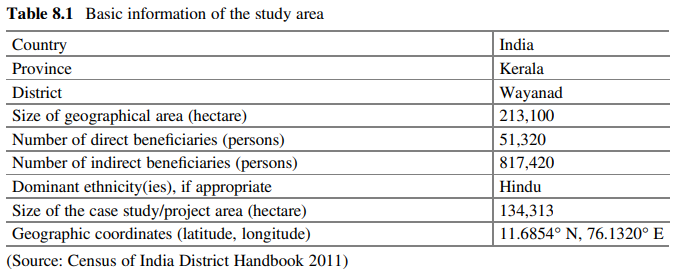
3 Methodology
A participatory rice seed production programme was initiated in 2011 with the objectives of conservation of the maximum possible rice crop genetic diversity and the building of capacity amongst rice cultivators to adapt to climate change and related vagaries in five villages of Wayanad district. The number of sites has increased to 30 villages as of 2021 (Fig. 8.3). The intervention started with documentation of traditional knowledge and practices, focusing on mobilisation of farming families that were cultivating rice and were interested in cultivation of Traditional Rice Varieties (TRVs). The intervention followed a step-by-step approach starting with community mobilisation, development of a farmers’ inventory, and problem identification, and moving on to training support in Good Agricultural Practices (GAP), quality seed production techniques ranging from seed selection to purification and storage, and facilitating market linkages. Necessary linkages were developed amongst the established seed villages and fellow farmers, marketing channels, agricultural officers, consumers, and other stakeholders. The results of the interventions were synthesised through various qualitative data collection methods, mainly semi-structured interviews, field observation, focus-group discussions, and key informant interviews. Resulting data was then analysed and interpreted.
Over a 10-year period, a range of interrelated activities covering the three thematic areas of biodiversity conservation, climate change adaptation, and livelihood development were undertaken (Fig. 8.4). The following three major activities were streamlined for concerted action.
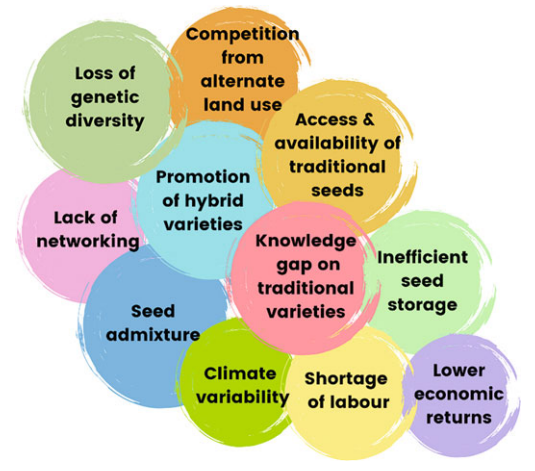
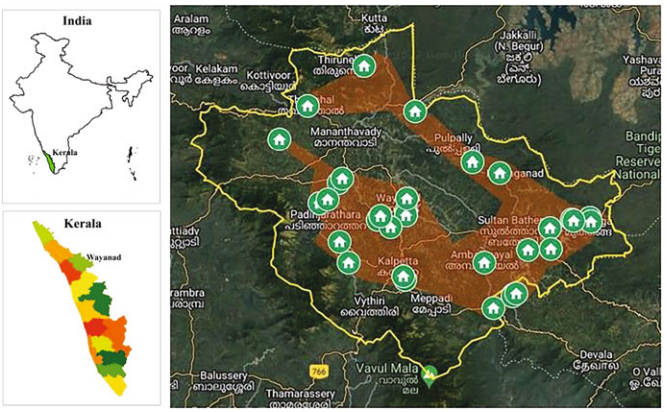
3.1 Farmers’ Training on Climate-Resilient Agricultural Practices
Starting in 2015, 27 training programmes have been conducted covering the selected subject areas, reaching 459 male and 274 female farmers from the RSVs. Trainings were provided on various climate-resilient practices—predominantly System of Rice Intensification (SRI) and Modified SRI (MSRI)—that helped the farmers to gain necessary skills in adapting to drought conditions. SRI is a climate-resilient practice of paddy cultivation developed in Madagascar and followed worldwide on account of the benefits it offers with respect to productivity and climate change (Thakur and Uphoff 2017). The adoption of SRI and MSRI by the RSV farmers allowed them to cultivate paddy under water scarcity and also helped them gain higher yields (20%) compared to the conventional method of rice cultivation. Training on preparation and usage of various organic nutrient formulations, like Jeevamrutham, Beejamrutham, Panchgavyam, and Fish Amino, also aided yield enhancement without harmful chemicals. Various other climate change adaptation practices when promoted amongst the community helped the farmers to mitigate and adapt to the effects of climate variability. These mainly included: cultivation of pulse or legume crops in the rice fields after the harvest; green manuring; application of soil nutrients in split doses; soil test-based nutrient application; change in sowing or transplanting dates in case of delayed monsoons; and establishment of nurseries in uplands. Floods in a way also revived the knowledge and value of traditional varieties amongst the new generation of farmers.
As part of the programme, indigenous knowledge documentation revealed various insights on the management practices followed in the past by paddy farmers, which are detailed below. This documented knowledge was validated during the training sessions for farmers, who were encouraged to revitalise these practices wherever possible in the fields.
- Communities determine the timing of sowing/transplanting and harvesting of the crop based on Paurnami, i.e. the lunar cycle. Further discussion with the farmers and agriculture experts revealed that during certain periods in the lunar cycle, rodents and pests stay away from the field and do not affect the crops.
- Farmers follow a range of eco-friendly management practices to manage diseases and pests in the field, such as: – Usage of a particular plant species (Ficus hispida) with a rough and spiny leaf surface to ward off insect larvae in the crop field. – Attracting owls—the natural predator of pests like rodents—and usage of stuffed owl feathers to avoid rodent attacks in the field, also help to reduce the use of chemicals and maintain the fabric of the natural food web. – Usage of cow dung slurry to provide extra nutrients to the crop, reducing dependence on chemical fertilisers.
- Grazing of cattle in the field after harvest was also facilitated with the cultivation of traditional varieties. Since the traditional varieties have more height and thicker straw, they are quite suited to livestock. Hence, the stubble left after the harvest can be easily utilised through grazing, which also promotes in situ manuring. Based on their traditional wisdom, the communities allow equitable distribution of manure by developing borders in the field for grazing and shifting the cattle over time to other fields.
Throughout the programme period, the associated knowledge was documented noting that such valuable wisdom if lost cannot be regained, making it very important to conserve for future farming generations. Researchers such as Deb (2014) have reported that the disappearance of traditional paddy varieties leads to loss of the associated traditional knowledge of farmers as well.
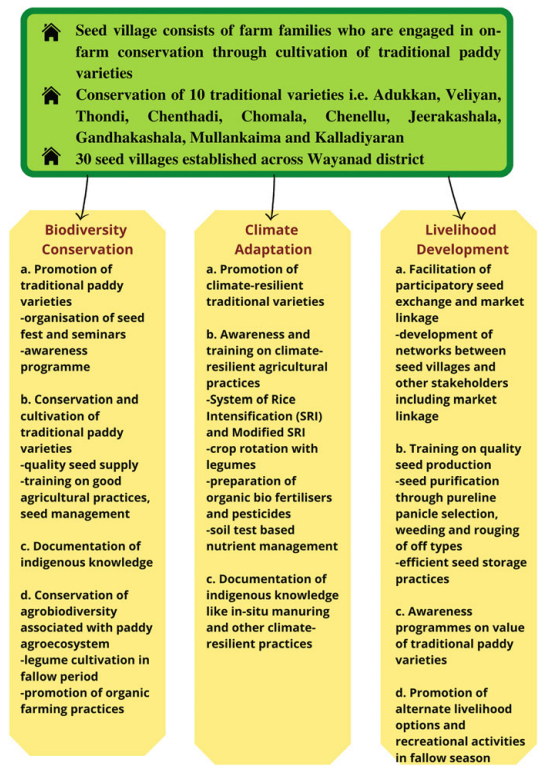
3.2 Facilitation of Participatory Seed Purification,
Exchange, and Market Linkage
The focus of this activity was to extend the programme’s aims past improving yields of rice to provide a strategic framework for conserving, consuming, and gainful marketing of grains and seeds of TRVs. In this context, the following steps were initiated: identifying maximum genetic variability of the varieties known to farmers; joint testing and selection by farmers and the MSSRF team on-site in differing targeted farm environments; and participatory seed exchanges. The TRVs selected for cultivation were determined based on the preferences of the farming communities. Factors included taste, size and shape of the grain, nutritional and aromatic properties, and the drought and/or flood resistance/tolerance of the varieties.
3.3 Organising Seed Festivals
As part of the intervention, seed festivals (Vittutsavam) were organised annually starting in 2014. These events provided the right platform to share knowledge related to farm agro-biodiversity and to stress its importance. With the participation of communities and support of local self-government and grassroots organisations, the programme remains a one-of-a-kind in the state. Seed festivals have allowed for the exchange of seeds of traditional rice varieties between farmers across the state of Kerala. Seeds of most traditional varieties are not easily available to farmers, but through this programme, farmers from various regions could access the seeds that they had lost over time due to lack of a market for their sale. Each seed festival witnessed the participation of more than a thousand visitors of different backgrounds and expertise. The programme also became a medium for knowledge exchange between the communities and academic experts through seminars and panel discussions. Over the years, knowledge exchange on agro-biodiversity governance, the need for community seed banks, resilient systems, networking, farmers’ rights, and other policy issues has been facilitated through the event, forming a farmer– scientist–official interface. Farmers engaging in conservation across the RSVs have showcased their farm diversity through exhibitions. Likewise, an interface between farming communities and other stakeholders like traders, the general public, students, and government officials have helped generate awareness on the rich genetic diversity of the region.
4 Results
Through the RSV programme, efforts were made to empower the communities through various means, such as participatory seed conservation and exchange, facilitating market linkage, introduction of alternate livelihood options, food and livelihood security, and awareness and knowledge creation. With REbA, the programme directly reached out to 340 farm families in the RSVs and more than 3000 farmers through various activities. The conservation of rice genetic diversity through these villages has aided the socio-economic development of over 300 farming families engaged in the cultivation of traditional rice varieties.
The RSV intervention helped to develop the capacity of farmers in maintaining the rice farming system ecology and to better use surplus seeds and grains with the new partnership established between other farmer groups and the larger rice markets. This is evidenced at present in the functioning of 30 RSVs in the Wayanad district (Table 8.2). The major outcomes of the intervention are described below.
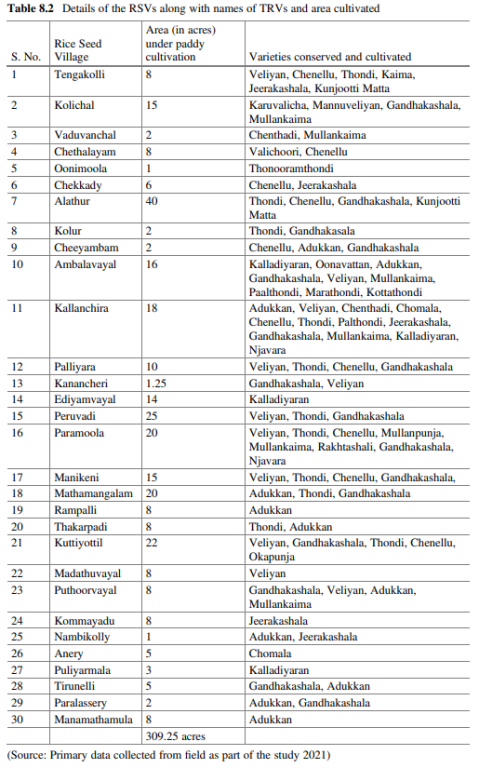
4.1 Conservation of Traditional Rice Varieties and Preservation of Ecosystem Services
With the establishment of the RSVs, farmers were helped to maintain the on-farm conservation of 20 traditional rice varieties (Mullankaima, ThonooramThondi, Karuvalicha,, Kunjootti Matta, Marathondi, Oonavattan, Chenthadi, Koduveliyan, Kalladiyaran, Valichoori, Chenellu, Gandhakashala, Chomala, Jeerakashala, Veliyan, Thondi, Kottathondi, Kaima, Mannuveliyan, and Adukkan). The seed improvement activity focused on 10 selected specialty rice varieties, namely Adukkan, Veliyan, Chenellu, Chenthadi, Chomala, Kalladiyaran, Thondi, Mullankaima, Jeerakashala, and Gandhakashala. These are special in terms of their characteristic traits like fragrance, medicinal or nutritional properties, tolerance or resistance to the weather variations, early or late maturity, and so on. Until this intervention, no markets existed for the sale of seeds of TRVs. Through the initiative, farmers were given access to quality TRV seeds for cultivation in exchange for returning the seeds the year after the harvest.
In a span of 6 years from 2015 to 2021 around 27.13 Qtl (2.71 tonnes) of seeds of traditional rice varieties were exchanged through participatory seed exchanges across Kerala (12 districts) and Tamil Nadu (three districts) states of India.
After the RSV programme intervention, there has been an increase in TRV cultivation area in the seed villages from 248 acres to 309.25 acres, a growth of 24.7%, which indicates the interest of farming communities in the cultivation of traditional rice varieties.
4.2 Promotion of Climate-Resilient Traditional Varieties
Many traditional varieties have been found to be tolerant to flood and drought conditions by farming communities. Hence, the interest in traditional varieties as a climate change adaptation strategy is increasing slowly and steadily. Gopi and Manjula (2018) have noted that farmers reported many varieties tolerant to flood and drought conditions in the region. These TRVs were promoted as part of the RSV programme alongside climate-resilient agricultural practices. Promotion of the Kalladiaran variety as a promising drought-tolerant and short-duration crop helped the farmers in RSVs to cope with the aftermath of heavy rainfall during monsoons. They were also able to cover losses in other varieties if cultivated after the rainy season. In the aftermath of recurrent floods in 2018 and 2019, seed exchanges of these varieties helped communities to cope with the damage caused. After these floods, the majority of farmers lost their seeds, and certain released varieties like Athira, Uma, and Airangana could not survive the submerged flood conditions. In this regard, the linkage of seed villages across Wayanad aided in the seed exchange of resilient traditional rice varieties. The intervention enabled the seed exchange of 170.2 kg in 2018, which increased to 1279.35 kg (1.28 tonnes) in 2019 after the floods and 767.2 kg (0.76 tonnes) in 2020. Moreover, seeds were supplied to other farmers from different regions thinking ahead to any further unexpected weather events. The seed festivals conducted after the disaster events also gave farming communities outside the RSV intervention areas access to resilient TRVs. Overall, the intervention directly benefitted 340 farming families in the RSVs and indirectly benefitted more than 3000 farming families. The proven adaptive qualities of traditional varieties were demonstrated in their resilience during the recurrent floods and gave minimum price assurance on account of the maintained grain quality.
A major intervention towards climate adaptation and improved soil fertility was the establishment of pulse farms in existing RSVs during the off-season. Paddy fields are generally left fallow in the region after the harvest; therefore, cultivation of other crops in the off-season was promoted as part of the programme. Cultivation of vegetable crops and pulses was facilitated through distribution of seeds and planting materials for seasonal vegetables, pulse crops, and elephant foot yam. From 2018 onwards, nine pulse farms were established on 64 acres of land, helping to improve the soil fertility and nutrients through cultivation of pulse crops (traditional varieties of cowpea) after the harvest of paddy. On fields that were previously kept fallow after the harvesting of paddy, cowpea cultivation and incorporation of green manuring helped enhance soil fertility as legumes are known to fix nitrogen and enhance the fertility of soil. This intervention not only helped improve soil health, but the crops also served as a source of vegetables for the farm families and fodder for farm animals.
4.3 Socio-Economic Empowerment
Through RSVs, the informal seed exchange system was revived into a more structured network for participatory seed exchange to ensure conservation and cultivation of TRVs. RSVs were linked with a marketing channel through a Farmer Producer Organisation (FPO) named WAMPCo. to facilitate the sale of grains. Before linking the farming community with the market, it was essential to develop quality seeds. Ensuring and maintaining the purity of seeds is imperative to harness the benefits and special features of the traditional varieties. It is a major challenge to ensure adequate production and supply of pure seeds when promoting the large-scale cultivation of specialty varieties. Training of RSV farmers on quality seed production through pure line panicle selection, weeding and rouging of off-types, and efficient seed storage practices led to the production of good quality seeds of the TRVs. The supply of 88 metal seed storage boxes to the RSVs protected the seeds from disease and pests and allowed better post-harvest management. Good quality seeds produced through the intervention allowed for better market linkage in return.
The RSV and seed festival interventions, coupled with similar initiatives taken by farmer-centred rice producer collectives, generated good awareness amongst consumers related to the nutritional qualities of traditional rice varieties.
With the intervention, linkage was facilitated between seed village farmers and markets, which eventually led farmers to fetch better prices compared to 24 INR/kg (about 0.30 USD) from the open market and smaller mills to 34 INR/kg (about 0.42 USD) from the Wayanad Rice Mill and certain FPOs interested in good quality seeds and grains of the Veliyan, Adukkan, Thondi, Chennelu, Chomala, Kalladiaran, and Chenthadi varieties.
Through the linkage, farmers were also able to fetch better prices for special aromatic rice varieties (Gandhakashala, Mullankaima, and Jeerakashala) that were promoted as part of the RSV intervention, not just from FPOs, but also from other potential buyers like Supply Co., other farmers, and private buyers. With the increased access to seeds of aromatic rice varieties, RSV farmers were able to cultivate these three varieties that sell at premium prices ranging from 70 to 110 INR/kg (0.86–1.35 USD). Due to increased consumer awareness, demand for these varieties gradually increased, resulting in premium prices roughly 40% higher than other varieties.
Furthermore, the networking of farmers with Seed Care, an association of traditional seed growers, also helped them to understand their rights and gain recognition amongst their peers. This helped communities to make strategic decisions regarding the quantity of seeds to be sold and other concerns regarding paddy cultivation. Developing a structured seed exchange network helped communities meet their livelihood needs in times of seasonal shortages, losses due to natural disasters, and other financial concerns.
In addition, as part of the seed festival programme, farmers were given recognition for their efforts in conservation of agro-biodiversity in the form of the “Community Agrobiodiversity Conservation Award” facilitated through the Wayanad Tribal Development Action Council (WTDAC), a grassroots organisation facilitated by MSSRF in the past. Over time, seed festivals have drawn wider attention to the value of traditional crop varieties. At every seed festival, two cash awards were rewarded to Adivasi farm families (indigenous community) from the region: one to the family that conserved the most native rice varieties (25,000 INR, or about 300 USD) and one to the family that conserved the most plant and animal breeds on farm (15,000 INR, or about 180 USD). These awards and recognition motivated other farmers and communities to make efforts to conserve agro-biodiversity. Accordingly, awareness on traditional varieties grew and created a higher demand amongst consumers, even at premium prices. As a result, the farming communities engaged in the cultivation of traditional varieties highly benefitted as they received better prices for their produce and recognition as well.
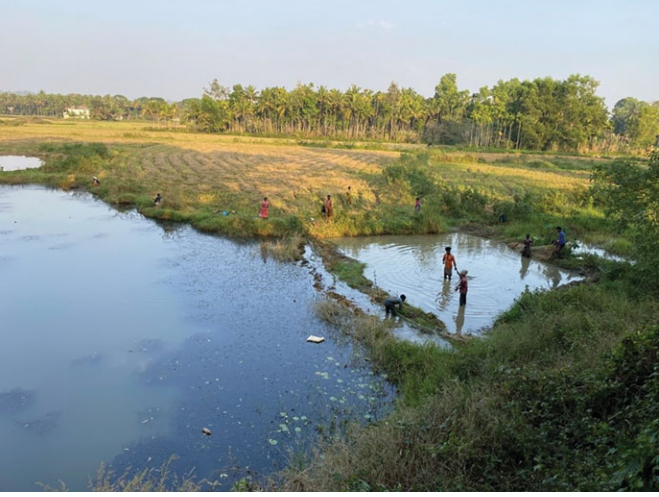
4.4 Promotion of Alternate Livelihoods and Recreational Activities
Some other alternate uses of paddy fields during the fallow season were also promoted as part of the intervention to allow for the expansion of livelihood opportunities. Instead of keeping the land fallow, paddy fields were utilised as ponds for fish cultivation (Fig. 8.5), and for the cultivation of vegetables and pulses that provided alternate livelihood options as well as nutrition security. During summer months, certain paddy fields were made into football playgrounds for youngsters, helping to create recreational activities for enjoyment.
5 Discussion: Opportunities, Challenges, and the Way Forward
The REbA approach based on interventions in the RSVs facilitated better management of the paddy agro-ecosystem, which can be termed as a vital socio-ecological production landscape (SEPL) in the context of local sustainable development. Over the period of the intervention, various opportunities and challenges were revealed that affect the rice paddy SEPL.
Rice paddies as a type of SEPL hold immense importance on account of the diverse benefits they provide to communities. The opportunities identified throughout the intervention period which require further interventions include: value addition to TRVs, protection and enhancement of agro-biodiversity, creation of more employment opportunities in the paddy agro-ecosystem, and development of community-centric solutions to address food and nutrition security through management of the paddy agro-ecosystem. Major challenges observed throughout the programme period with respect to interventions and paddy cultivation were: increasing climate variability, expansion of cash crops, shortage of labour, insufficient incentives for farmers engaged in conservation, lack of community-centric agricultural innovations, and increased use of chemical fertilisers and pesticides. Future efforts need to be made to address these challenges by implementing development interventions in the concerned areas.
As evident from field observations and various reports, Wayanad has been experiencing various weather vagaries over the past few years, particularly the continuous occurrence of floods due to erratic rainfall during the monsoon season and drought conditions during the summers. Studies indicate the importance of implementing farm management practices based on agro-biodiversity and ecosystem services that provide adaptation benefits in light of climate change (van Noordwijk et al. 2018). Field interviews and observations showed how resilient some traditional varieties were to harsh weather conditions, such as droughts and floods. Veliyan, one of the traditional rice varieties, is especially worth mentioning as it has the particular traits of being tolerant to both flood and drought. Farmers also mentioned two different variants, namely Chettuveliyan (best for marshy land) and Mannuveliyan (best for sandy dry soil), for their climate-resilient qualities. Similar results have also been reported in a study done by Gopi and Manjula (2018) that mentioned a number of traditional varieties with climate resilience in Wayanad, i.e. flood-tolerant (Adukkan, Veliyan, Chenthadi) and drought-tolerant (Kalladiaran, Veliyan, Thondi) varieties. Further impetus is needed for field-based agronomical studies and lab-based research to delve deeper into the characteristics of resilient varieties and work to mainstream them in production systems.
It is evident that agro-ecosystems have undergone significant degradation on account of various anthropogenic activities, leading to the loss of agro-biodiversity. Wayanad, as stated above, has also undergone momentous changes in its agroecosystem due to land use changes, modern agriculture techniques, anthropogenic activities, and climate change. Hence, taking action for ecosystem restoration was quite necessary to retain or enhance the biodiversity of the paddy agro-ecosystem. The intervention through the RSVs was a major step towards conservation of agrobiodiversity and enhancement of livelihoods. Ecosystem restoration, as reported by Gann and Lamb (Eds., Gann and Lamb 2006), should improve biodiversity conservation, improve livelihoods, empower local people, and improve ecosystem productivity.
Through the establishment of RSVs, the traditional genetic diversity of rice paddies was conserved by improving access to and the availability of 10 traditional rice varieties, along with the increase in area under cultivation (from 248 to 309.25 acres) due also to the special characteristics of such varieties in relation to aroma, nutrition, and climate change. Moreover, through the intervention, improved access to desired seeds helped improve the livelihoods of the families engaged in traditional paddy cultivation. The intervention facilitated the linkage between farmers and potential buyers interested in the purchase of selected traditional varieties, thus enabling farmers to receive better remuneration for their produce. Furthermore, timely events like seed festivals and the training and capacity-building programmes also led to the socio-economic uplifting of the communities. As an outcome of the intervention governed with RSVs, local self-governance in the region, especially the Panchayati Raj Institutions initiated remunerative schemes for farmers that are conserving traditional rice varieties. Special subsidies were announced for farmers cultivating Jeerakashala and Gandhakashala varieties to encourage conservation of specialty rice varieties. Still, similar efforts are needed to encourage farmers to not only grow aromatic rice varieties but other traditional varieties as well for restoration of traditional paddy agro-ecosystem in long term. In a broader context, efforts in agro-biodiversity conservation and socio-economic empowerment of the farm families in the paddy SEPL of Wayanad are the primary stepping stones towards ecosystem restoration efforts in the future.
6 Conclusion
Through the integrated interventions, the REbA approach helped smallholder rice farming communities in Wayanad to improve their climate adaptation practices. The RSV programme resulted in stopping on-farm erosion of rice genetic diversity and created wider awareness of the nutritional and climate-resilient qualities of traditional rice varieties. RSVs as part of the intervention have taken up cultivation of atleast two to atmost eight traditional varieties and thus have led to conservation of the associated diversity of flora and fauna in rice fields. The increased consumer awareness on the therapeutic and nutritional value of some of the traditional rice varieties ensured better premium prices in the market and aided in the improvement of livelihoods in the farming communities. Awareness created amongst governance institutions, like the Panchayati Raj Institution (PRI) members, helped to increase allocation of funds as production subsidies, and special subsidies for medicinal and aromatic rice varieties. The farmers of the seed villages are able to sell their excess produce every year at a good rate, which provides them with better returns from the local market. The programme generated impacts in reviving the resilient, climatefriendly agricultural practices and varietal diversity owned by the traditional rice genous knowledge associated with traditional paddy cultivation was also revived with the conservation of TRVs. The RSV programme gave an alternative solution to the problems associated with informal seed systems and declining rice diversity, making communities more self-reliant and self-sufficient through conservation, cultivation, marketing, and consumption of TRVs. Similar interventions are needed to pass on the agricultural heritage of indigenous communities merged with scientific knowledge to build resilient farming systems in the future. An enabling environment must be created that can serve the dual purpose of conservation of agro-ecosystems along with the development of sustainable livelihoods for farming communities.
Acknowledgements This study would not have been possible without the support of the Department of Science & Technology, Government of India, the invaluable cooperation of the farming communities, field professionals at MSSRF-CAbC, and other government and non-government personnel. We wholeheartedly acknowledge the support provided throughout the entire study period.
References
Chivenge P, Angeles O, Hadi B, Acuin C, Connor M, Stuart A, Puskur R, Johnson-Beebout S (2020) Ecosystem services in paddy rice systems. In: Rusinamhodzi L (ed) The role of ecosystem services in sustainable food systems. Academic Press, pp 181–201
Cox PA (2000) Will tribal knowledge survive the millennium? Science 287:44–45. https://doi.org/ 10.1126/science.287.5450.44
Deb D (2014) Folk rice varieties, traditional agricultural knowledge and food security. In: Alvarez C (ed) Multicultural knowledge and the university. Multiversity and Citizens International, Penang, pp 45–57
Easterling WE, Aggarwal PK, Batima P, Brander KM, Erda L, Howden SM, Kirilenko A, Morton J, Soussana JF, Schmidhuber J, Tubiello FN (2007) Food, fibre and forest products. In: Parry ML, Canziani OF, Palutikof JP, van der Linden PJ, Hanson CE (eds) Climate change 2007: impacts, adaptation and vulnerability. Cambridge University Press, Cambridge, pp 273–313
Eliazer Nelson ARL, Ravichandran K, Antony U (2019) The impact of the green revolution on indigenous crops of India. J Ethnic Foods 6(1):1–10
Food and Agriculture Organization (FAO) (2009) How to feed the world in 2050. Popul Dev Rev 35(4):837–839. https://www.fao.org/fileadmin/templates/wsfs/docs/expert_paper/How_to_Feed_the_World_in_2050.pdf
Fox TA, Rhemtulla JM, Ramankutty N, Lesk C, Coyle T, Kunhamu TK (2017) Agricultural landuse change in Kerala, India: perspectives from above and below the canopy. Agric Ecosyst Environ 245:1–10
Gann GD, Lamb D (eds) (2006) Ecological restoration: a means of conserving biodiversity and sustaining livelihoods. Society for Ecological Restoration International, Arizona
Godfray HCJ, Beddington JR, Crute IR, Haddad L, Lawrence D, Muir JF, Pretty J, Robinson S, Thomas SM, Toulmin C (2010) Food security: the challenge of feeding 9 billion people. Science 327(5967):812–818
Government of Kerala (GoK) (2011) Panchayath level statistics. Various Districts in Kerala, Department of Economics and Statistics, Government of Kerala, Thiruvananthapuram
Government of Kerala (GoK) (2019) Agricultural statistics 2019–20. Department of Economics & Statistics. Government of Kerala, Thiruvananthapuram, p 11p
Gopi G, Manjula M (2018) Speciality rice biodiversity of Kerala: need for incentivising conservation in the era of changing climate. Curr Sci 114:997–1006
Hari A, Kumar NK (2016) Scenario analysis of rice cultivation in Kerala. J Extens Educ 28(4):5760–5763
Jose M, Raj RD, Vinitha MR, Madhu R, Varghese G, Bocianowski J, Yadav R, Patra BC, Singh ON, Rana JC, Kurmari SL (2018) The prehistoric Indian Ayurvedic Rice Shashtika is an extant early domesticate with a distinct selection history. Front Plant Sci 9:1203
KAU (2018) WayanadanNellinangal: directory of farmers conserving traditional rice varieties, Govt of Kerala Dept of ag. Dev. and Farmers Welfare – Kerala Agricultural University
Kumar BM, Kunhamu TK (2021) Ecological and historical perspectives of rice cultivation in Kerala: a synthesis. ORYZA-An Int J Rice 58(2):241–261
Kumar BM, Takeuchi K (2009) Agroforestry in the Western Ghats of peninsular India and the satoyama landscapes of Japan: a comparison of two sustainable land use systems. Sustain Sci 4(2):215–232
Kumar NA, Lopus M, Raveendran T, Vipindas. (2022) Making Rice-farming system more climate resilient and nutrition sensitive: heritage of Kurichiya tribe Community of Western Ghats. In: Rakshit A, Chakraborty S, Parihar M, Singh Meena V, Kumar Mishra P, Bahadur Singh H (eds) Innovation in small-farm agriculture. Taylor & Francis, pp 287–297
Kumar P (2017) Green revolution and its impact on environment. Int J Res Humanities Soc Sci 5(3): 54–57
Maffi L (2002) Endangered languages, endangered knowledge. Int Soc Sci J 54(173):385–393
Manilal KS (1991) Ethnobotany of the Rices of Malabar. In: Contribution to ethnobotany of India. Scientific Publishers, Jodhpur, pp 243–253
Millennium Ecosystem Assessment (2005) Ecosystems and human Well-being: synthesis. Island Press, Washington, DC
Parameswaran P, Kumar AN (2017) An account of the ‘useful weeds’ associated with wetland paddy fields (Vayals) of Wayanad, Kerala, India. Ann Plant Sci 6(1):1516–1526
Parayil G (1992) The green revolution in India: a case study of technological change. Technol Cult 33(4):737–756
Richharia R, Govindasamy S (1990) Rices of India. Academy of Development Science, Karjat
Roy K, Mukherjee A, Maity A, Shubha K, Nag A (2018) Protecting non-basmati indigenous aromatic rice varieties of West Bengal, India under geographical indication: a critical consideration. In: Roy C (ed) The role of intellectual property rights in agriculture and allied sciences. Apple Academic Press, pp 295–318
Salinger MJ, Sivakumar MVK, Motha R (2005) Reducing vulnerability of agriculture and forestry to climate variability and change: workshop summary and recommendations. In: Salinger J, Sivakumar MVK, Motha RP (eds) Increasing climate variability and change. Springer, Dordrecht, pp 341–362
Sathya A (2013) Are the Indian rice landraces a heritage of biodiversity to reminisce their past or to reinvent for future? Asian Agri-History 17:221–232
Secretariat of the Convention on Biological Diversity (CBD) (2009) Connecting biodiversity and climate change mitigation and adaptation: report of the second ad hoc technical expert group on biodiversity and climate change, Montreal. Tech Series 41:126
Thakur AK, Uphoff NT (2017) How the system of rice intensification can contribute to climatesmart agriculture. Agron J 109(4):1163–1182
Umadevi M, Pushpa R, Sampathkumar KP, Bhowmik D (2012) Rice-traditional medicinal plant in India. J Pharmacogn Phytochem 1(1):6–12
van Noordwijk M, Duguma LA, Dewi S, Leimona B, Catacutan DC, Lusiana B, Öborn I, Hairiah K, Minang PA (2018) SDG synergy between agriculture and forestry in the food, energy, water and income nexus: reinventing agroforestry? Curr Opin Environ Sustain 34:33–42
Zeng Y, Zhang H, Wang L, Pu X, Du J, Yang S, Liu J (2010) Genotypic variation in element concentrations in brown rice from Yunnan landraces in China. Environ Geochem Health 32(3): 165–177
Note
The opinions expressed in this chapter are those of the author(s) and do not necessarily reflect the views of UNU-IAS, its Board of Directors, or the countries they represent.
Open Access This chapter is licenced under the terms of the Creative Commons AttributionNonCommercial-ShareAlike 3.0 IGO licence (http://creativecommons.org/licenses/by-nc-sa/3.0/ igo/), which permits any noncommercial use, sharing, adaptation, distribution and reproduction in any medium or format, as long as you give appropriate credit to UNU-IAS, provide a link to the Creative Commons licence and indicate if changes were made. If you remix, transform, or build upon this book or a part thereof, you must distribute your contributions under the same licence as the original. The use of the UNU-IAS name and logo, shall be subject to a separate written licence agreement between UNU-IAS and the user and is not authorised as part of this CC BY-NC-SA 3.0 IGO licence. Note that the link provided above includes additional terms and conditions of the licence.
The images or other third party material in this chapter are included in the chapter’s Creative Commons licence, unless indicated otherwise in a credit line to the material. If material is not included in the chapter’s Creative Commons licence and your intended use is not permitted by statutory regulation or exceeds the permitted use, you will need to obtain permission directly from
the copyright holder.

